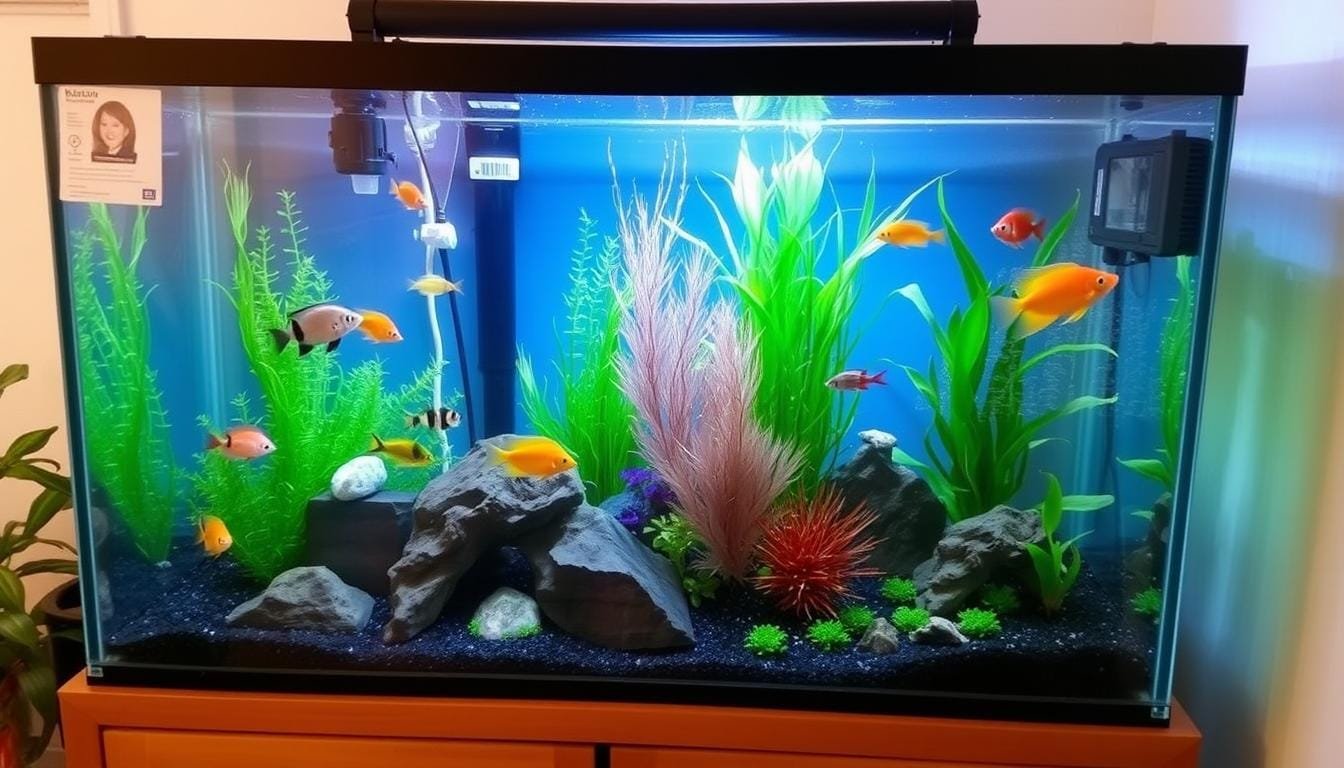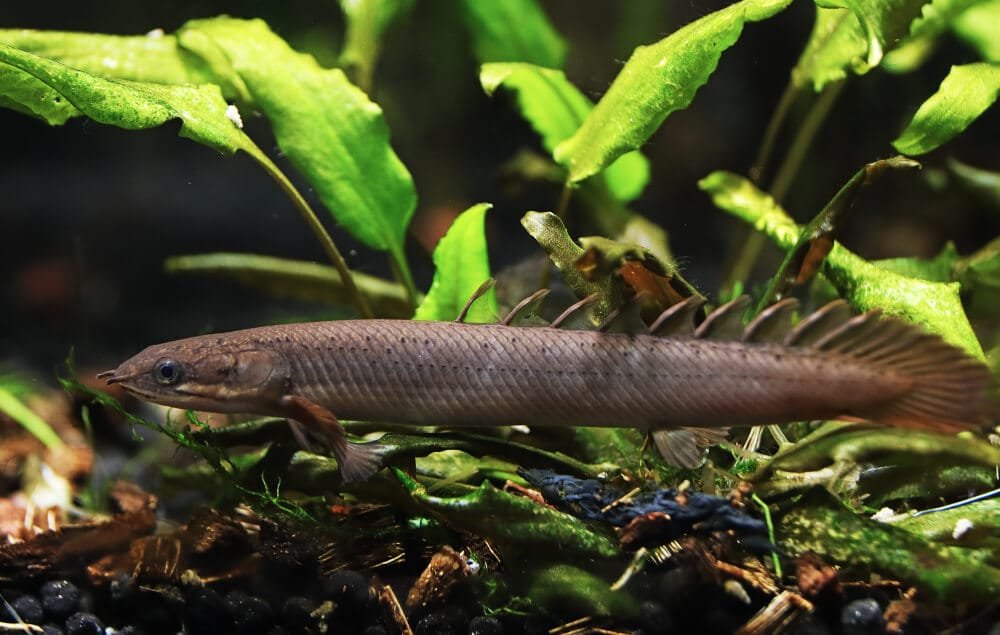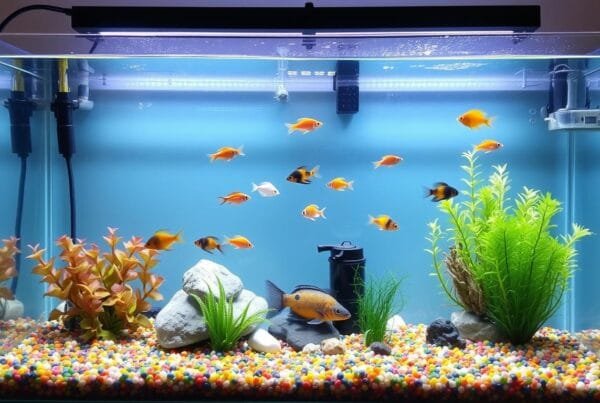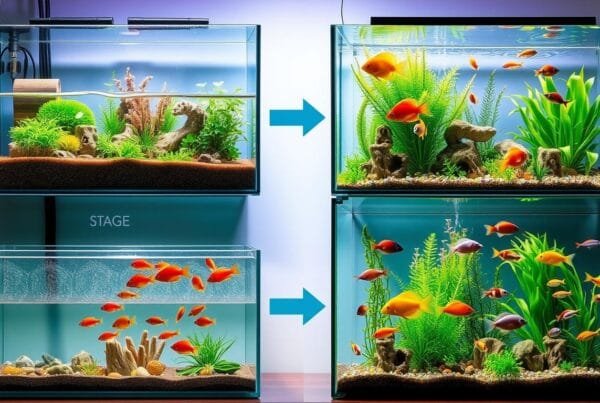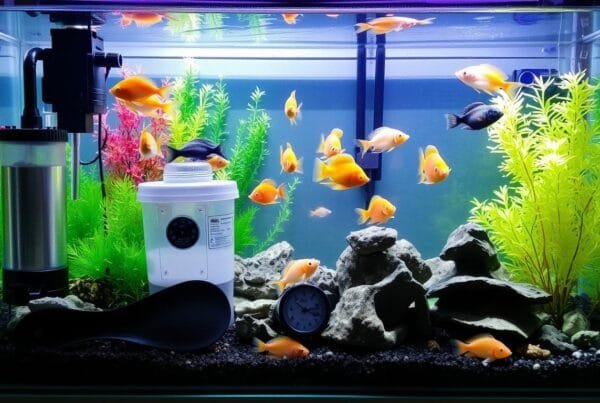Did you know people have kept fish in tanks for about 4,500 years? With better tools and techniques, starting a fish tank is easier now. When picking the best aquarium for beginners, think about space, budget, and the fish you want. A bigger tank, over 30 gallons, is best for beginners because it’s more stable.
Setting up an aquarium needs some planning, but it’s doable with the right help. We’ll talk about the key equipment you need, like filters, heaters, and lights. We’ll also suggest the best aquariums for beginners to help you choose your first tank.
Key Takeaways
- Consider a larger aquarium, greater than 30 gallons, for increased stability during operations
- Choose an easy aquarium set up with essential equipment, including filters, heaters, and lighting
- Select a top beginner aquariums that fits your space and budget
- Plan for regular maintenance, including water changes and filter replacements
- Research and understand the needs of your fish, including feeding and water temperature requirements
- Invest in a high-quality dechlorinator to ensure healthy water conditions for your fish
- Consider the benefits of a beginner-friendly fish tank, including stress reduction and aesthetic appeal
Understanding Aquarium Basics
Setting up an aquarium starts with knowing the aquarium basics. You need to understand the different types of aquariums like freshwater, saltwater, and brackish water tanks. It’s also key to learn about aquarium terms like filtration, water chemistry, and biological balance.
Think about the benefits of aquariums before you start. They can help reduce stress, improve air quality, and bring joy from watching aquatic life. For tips on starting a freshwater aquarium, check out this guide.
- Guideline for stocking: 1 inch of adult fish per gallon of water (excluding tail)
- Adequate guideline for surface area: 1 inch of adult fish for every 24 square inches of surface area for tropical fish
- Requirement for cold-water fish (e.g., goldfish): 30 square inches of surface area per inch of fish
Learning these basics will help you create a thriving and healthy aquarium.
| Aquarium Type | Surface Area | Stocking Guideline |
|---|---|---|
| Freshwater | 24 square inches per inch of fish | 1 inch of adult fish per gallon of water |
| Saltwater | Varies depending on species | 1-2 inches of adult fish per gallon of water |
Best Aquarium for Beginners: Top Recommendations
Choosing the right aquarium for beginners can be exciting. A 20-gallon tank is a great start, as it’s stable for fish. Glass tanks are also a good pick because they’re affordable and durable. For more info, check out this guide on beginner-friendly equipment.
Beginner aquariums should be easy to use and maintain. They should also be affordable. Look for tanks with equipment like filters and heaters that are easy to use. It’s also important to think about the fish you want. Some fish need specific water conditions.
Here are some benefits of popular aquarium sizes:
- 20-gallon tank: provides a stable environment for fish to thrive
- 30-gallon tank: offers a more tolerable dilution for ammonia spikes compared to smaller tanks

Choosing the right equipment is key. Make sure your filters can clean the tank’s water twice an hour. By picking the best aquarium for beginners, you’ll create a beautiful space that relaxes you.
| Tank Size | Benefits |
|---|---|
| 20-gallon | Stable environment, easy to maintain |
| 30-gallon | More tolerable dilution for ammonia spikes |
Selecting the Right Tank Size
Choosing the right tank size is key for a thriving aquarium. The tank size affects the fish and plants you can have. It also impacts the ecosystem’s stability. A small tank is hard to keep stable, while a large tank is more stable but costly.
A medium tank is great for beginners. It balances ease and cost. Popular sizes for beginners are 10-gallon, 20-gallon, and 55-gallon tanks. It’s important to think about the space for fish to swim and breathe.
When picking a tank size, think about the fish and plants you want. A small tank is good for shrimp and some plants. But, it’s not enough for a school of fish. A large tank can handle more fish and is more stable.
Essential Equipment for Your First Tank
Starting a beginner’s aquarium needs essential equipment for fish health. Key items include filters, heaters, lighting, and test kits. A quality test kit is vital for checking the tank’s readiness for fish.
Choosing the right beginner-friendly equipment depends on your tank size and fish type. For instance, a 20-gallon tank needs a filter that can handle at least 80 gallons per hour (GPH). Heaters should match the tank’s size, with 5 watts per gallon for smaller tanks.
Other must-haves are:
- Gravel or substrate to line the tank
- Water conditioners to remove chlorine and heavy metals
- Lighting for plant growth and visibility
- A lid to keep fish from jumping out
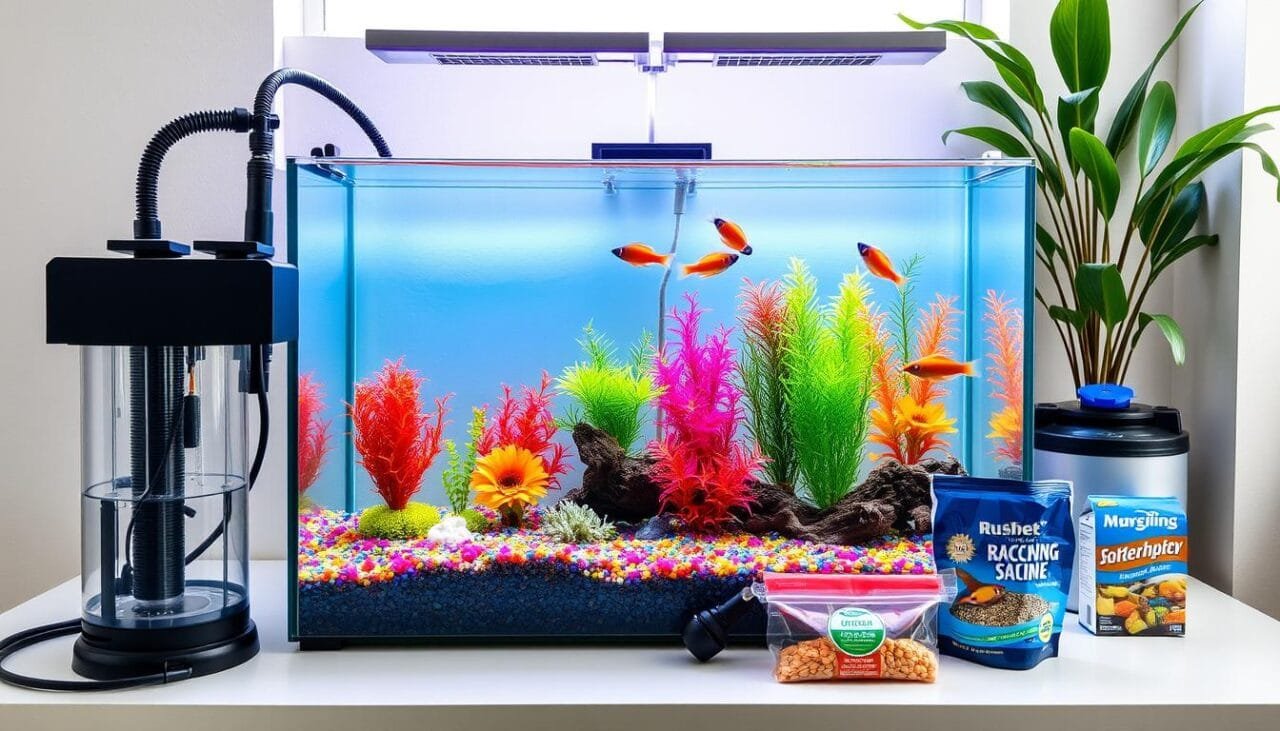
Investing in the right aquarium equipment helps create a thriving fish environment. Always pick beginner-friendly equipment that fits your tank size and needs.
| Equipment | Description |
|---|---|
| Filter | Removes waste and debris from the water |
| Heater | Regulates the water temperature |
| Lighting | Promotes plant growth and visibility |
Setting Up Your Filtration System
A good filtration system is key for a healthy aquarium. With so many fish owners around the world, a working filter is vital. The filtration system keeps your tank clean by removing waste and decaying matter.
When picking a filter, think about the filter types like mechanical, biological, and chemical. The filter size must match your tank’s size and fish population. Regular upkeep, like cleaning and replacing parts, keeps your filter running smoothly.
Some important filter maintenance tips include:
- Replace activated carbon every 4-6 weeks
- Change or rinse mechanical filters like floss and sponge
- Don’t use tap water to rinse biological media to protect bacteria
Knowing about filter types and filter size helps. Also, understanding maintenance requirements ensures your aquarium stays healthy with a good filtration system.
Water Chemistry and Parameters
Keeping an eye on water chemistry and water parameters is key for a healthy aquarium water quality. You should check the pH, ammonia, nitrite, and nitrate levels often. Most freshwater fish do well in water with a pH between 6.5 and 8.0.
South American fish and Caridina crystal shrimp like lower pH levels. African cichlids and livebearers prefer higher pH levels.
A quality test kit is vital for checking if your water is ready for fish. The ideal KH levels for freshwater aquariums are 4-8 dKH, or 70-140 ppm. GH levels should also be between 4-8 dGH, or 70-140 ppm.
Low GH can cause problems like poor appetite, slow growth, lethargy, and faded colors in fish.
To keep your water chemistry and water parameters in check, do regular water changes. Use a multi-test strip to quickly check pH, KH, and GH levels. Following these steps will help you create a healthy home for your fish.
Substrate and Decoration Options
Choosing the right substrate and decorations is key for a beautiful and healthy aquarium. The substrate lines the tank’s bottom and can be gravel, sand, or live plants. Each has its own benefits and drawbacks, depending on the aquarium type and its inhabitants.
Inert substrates like gravel and sand are best for freshwater fish tanks for looks. Sand is great for burrowing fish, but it can clog filters. Coarse substrates like pea gravel are popular for their easy maintenance and plant anchoring.
When picking substrate and decorations, consider these points:
* Gravel: easy to clean, various colors
* Sand: good for burrowing fish, may compact
* Live plants: natural food, shelter, and water quality help
* Decorations: rocks, driftwood, and ornaments add interest
The substrate depth is also important. A deeper layer helps plants grow better. Mixing substrates can make the tank look natural and enhance its beauty. The right choice depends on the tank’s needs and its life.
| Substrate Type | Benefits | Drawbacks |
|---|---|---|
| Gravel | Easy to clean, comes in various colors | Can be prone to compaction |
| Sand | Ideal for burrowing fish, can help maintain water quality | Can be prone to compaction, may require more frequent cleaning |
| Live Plants | Provide natural food and shelter for fish, can help maintain water quality | May require more maintenance, can be prone to disease |
Lighting Requirements and Options
When it comes to aquarium lighting, there are several factors to consider. These include lighting requirements, options, and the impact on fish health. The right lighting can make your aquarium look great and help plants grow well.
Key considerations for aquarium lighting include duration, intensity, and spectrum. Most aquariums need 8 hours of light a day for healthy plants and to prevent algae. The light intensity depends on your fish and plants’ needs, ranging from low to high.
There are many lighting options like LED, T5, and T8. Each has its own benefits. For example, LED lighting is energy-efficient and lasts long, making it a favorite among many.

It’s important to think about your fish and plants’ specific needs. Some plants and fish need low or high light to thrive. Choosing the right lighting is key for their health.
| Lighting Type | Energy Efficiency | Lifespan |
|---|---|---|
| Incandescent | 5-10% | Short |
| Metal Halide | 25-45% | Medium |
| Fluorescent | 40-60% | Medium |
| LED | High | Long |
By considering these factors and choosing the right aquarium lighting, you can create a healthy environment for your fish and plants.
Selecting Beginner-Friendly Fish Species
Choosing the right fish for your aquarium is key. Look for beginner-friendly and hardy species. These fish do well in a clean tank with the right water and care. Guppies, neon tetras, and corydoras catfish are great for beginners.
Before adding fish, think about fish compatibility. Make sure the fish you choose can live together. Some fish like to be in groups, while others prefer to be alone. Knowing this helps create a peaceful aquarium.
Stocking Guidelines
It’s important to follow stocking guidelines for your fish’s health. Too many fish can make the water dirty and stress them out. A good rule is to have 1-2 inches of fish per gallon of water. But, some fish need more space because of their size or how they swim.
Here are some tips for stocking your tank:
- Find out how big the fish will get and how they swim
- Think about the size of your tank and what equipment you have
- Start with a few easy-to-care-for fish and then add more
By following these tips and thinking about fish compatibility and stocking guidelines, you can have a happy aquarium. For more info on hardy fish and their care, check out fishkeepingadventure.com.
| Fish Species | Adult Size | Tank Size |
|---|---|---|
| Guppies | 1-2 inches | 10 gallons |
| Neon Tetras | 1-2 inches | 10 gallons |
| Corydoras Catfish | 1-3 inches | 10 gallons |
The Nitrogen Cycle and Tank Cycling
The nitrogen cycle is key in aquarium cycling. It’s where good bacteria turn ammonia into nitrites and then nitrates. This whole process can take weeks to months. Knowing about the nitrogen cycle and tank cycling is vital for a healthy aquarium.
For bacteria to grow well, ammonia levels should be at least 3 ppm. A cycled tank should have 0 ppm ammonia and nitrites, with some nitrates. If nitrates hit 40 ppm or more, it’s time for water changes to keep fish healthy. Proper biological filtration is also important to handle fish waste.
Here are some key points to consider when tank cycling:
- Aquariums generally take between 4 to 8 weeks to complete the cycling process.
- The ideal pH range for proper nitrogen cycle activity is between 7.0 and 7.8.
- The recommended temperature range during cycling is 83°F to 87°F.
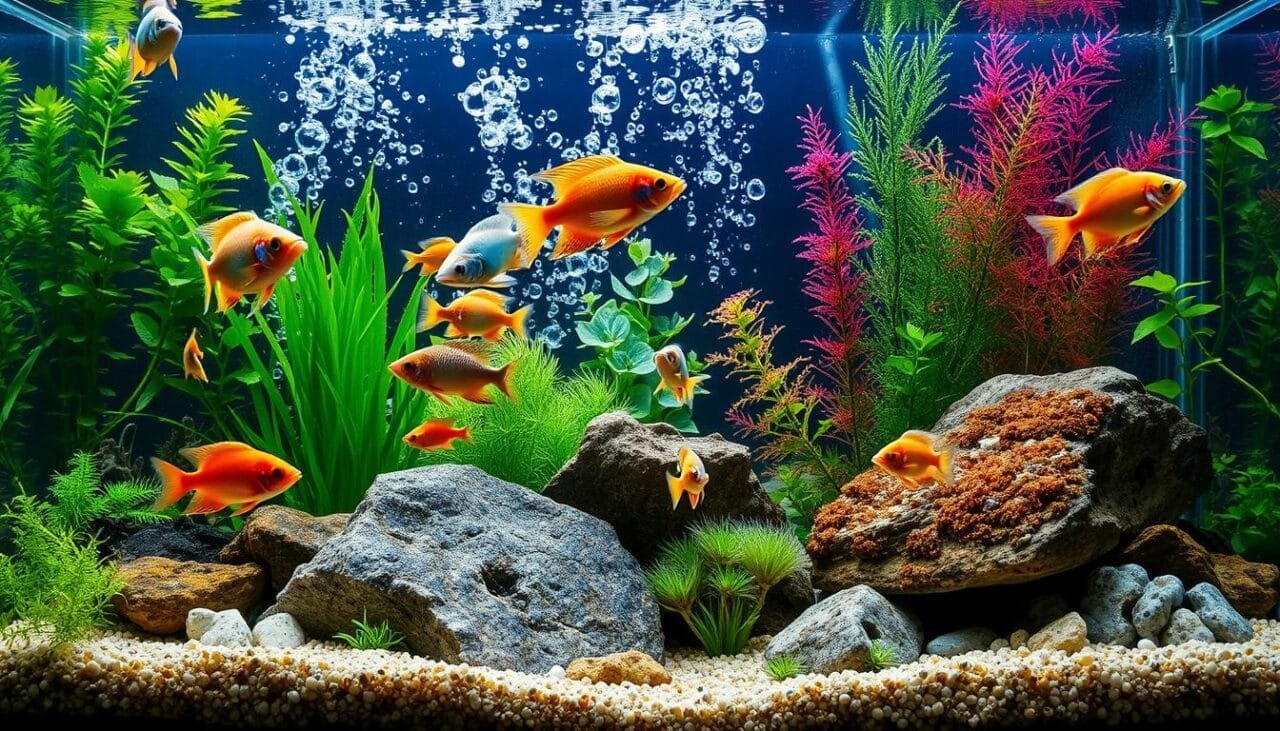
It’s best to add fish one or two at a time to avoid overloading the biofilters. Check for ammonia, nitrite, and nitrate levels every 1 to 2 days. By following these steps, you can make your aquarium a thriving and healthy place.
| Parameter | Ideal Measurement |
|---|---|
| Ammonia | 0 ppm |
| Nitrites | 0 ppm |
| Nitrates | Below 40 ppm |
Daily and Weekly Maintenance Tasks
Keeping your aquarium healthy is key. Daily maintenance tasks are quick, like checking water temperature and pH levels. Also, weekly tasks like partial water changes are vital for water quality.
Stick to a water change schedule to keep water clean. Change 10% of the water weekly and 25% monthly. Don’t forget to clean the tank and check equipment regularly.
Some important tasks include:
- Daily fish counts to detect dead fish quickly
- Weekly water testing to monitor ammonia, nitrite, and nitrate levels
- Monthly maintenance of filtration systems, including rinsing pre-filters and replacing carbon filters
Regular maintenance helps avoid problems and keeps your aquarium thriving.
| Maintenance Task | Frequency |
|---|---|
| Daily fish counts | Daily |
| Weekly water testing | Weekly |
| Monthly filtration system maintenance | Monthly |
Common Beginner Mistakes to Avoid
Setting up an aquarium can be tricky. Beginner mistakes can harm your fish and tank health. One big mistake is overfeeding, which causes waste and bad water.
To avoid common mistakes, learn the basics of aquarium care. This includes regular water changes, good filtration, and picking the right fish. For example, change 30% of the water weekly. For smaller tanks, up to 80% is okay. Learn more about common aquarium mistakes and how to steer clear of them.
Here are some tips to avoid beginner mistakes:
- Regular water changes keep water quality good
- Pick fish that get along with each other
- Don’t overfeed or overstock to avoid waste and bad water
By following these tips, you can have a healthy aquarium. Remember, aquarium mistakes can be expensive. But with the right advice, you can enjoy your aquatic world.
Budget Planning and Cost Considerations
Setting up an aquarium requires careful budget planning for a fun hobby. The cost for a saltwater aquarium can be between $425 and $1,800. This depends on the system and equipment you choose.
When planning your aquarium budget, consider the tank size. A bigger tank means more equipment and upkeep, raising the cost. For instance, a 40-gallon breeder tank costs less than $60. But, setting up a saltwater aquarium can cost between $900 and $1,800, based on your choices.
- Tank and equipment: $60-$100
- Filtration system: $50-$200
- Lighting: $50-$300
- Heater: $20-$50
- Other equipment and supplies: $100-$300
By planning well and considering these cost considerations, you can make a realistic aquarium budget. This way, you can enjoy a thriving and beautiful aquarium.
Conclusion: Starting Your Aquarium Journey
Starting your aquarium journey requires patience and dedication. With the right tools and knowledge, you can enjoy the many benefits of aquarium keeping. A beginner’s guide, like the one on starting an aquarium, offers valuable insights and tips.
The cycling process for a new aquarium takes 2-6 weeks. This time is needed to establish beneficial bacteria for water quality. Regular water changes, like changing 20-30% every 1-2 weeks, are also key. By following these steps and avoiding common mistakes, you can create a balanced and thriving ecosystem for your fish.
As you continue your aquarium journey, it will become second nature. The rewards of this hobby will become clear. With the right mindset and resources, you can enjoy a beautiful and thriving aquarium. It will bring you joy for years to come.
FAQ
What are the key factors to consider when choosing the best aquarium for beginners?
When picking an aquarium, think about space, budget, and the fish you want. Ease of use and affordable equipment are also key. These factors help you set up a great aquarium.
What are the different types of aquariums available for beginners?
Beginners can choose from freshwater, saltwater, or brackish water tanks. Freshwater tanks are easy to care for and a good start.
What is the importance of understanding aquarium basics for setting up and maintaining a healthy aquarium?
Knowing about filtration, water chemistry, and balance is vital. It ensures a healthy home for your fish and other aquatic life.
What are the benefits of keeping an aquarium, and how can it improve my life?
An aquarium can reduce stress, improve air quality, and bring joy. It also teaches responsibility and calmness, making it a great hobby.
What are the top recommendations for the best aquariums for beginners, and what equipment do I need to get started?
Start with a beginner-friendly kit that includes a tank, filter, heater, and lighting. These are easy to use and won’t break the bank.
How do I select the right tank size for my space and budget, and what are the considerations for small, medium, and large tanks?
Choose a tank size based on your space, budget, and fish needs. Small tanks are good for small spaces, while larger tanks offer more room and stability.
What are the essential equipment and supplies needed to set up and maintain a beginner’s aquarium, and how do I choose the right equipment for my tank?
You’ll need filters, heaters, lighting, and test kits. Opt for easy-to-use, affordable options. A beginner kit is a great starting point.
How do I set up a filtration system, and what are the different types of filters available for my aquarium?
A good filtration system is key for a healthy tank. There are mechanical, biological, and chemical filters. Choose the right size based on your tank’s needs.
What are the importance of water chemistry and parameters, and how do I monitor and maintain good water quality in my aquarium?
Water chemistry is critical for a healthy tank. Monitor pH, ammonia, nitrite, and nitrate levels. Regular water changes and proper filtration help keep water quality high.
What are the different substrate and decoration options available for my aquarium, and how do I choose the right substrate and decorations for my tank?
You can choose from gravel, sand, live plants, rocks, and driftwood. Pick a substrate that’s easy to clean and supports your fish’s health. Decorations should be safe and add interest.
What are the lighting requirements and options for my aquarium, and how do I choose the right lighting for my tank?
Lighting is important for your fish’s health. LED, T5, and T8 lights are options. Choose the right spectrum, intensity, and duration for your fish and plants.
What are the best beginner-friendly fish species, and how do I choose the right fish for my aquarium?
Start with hardy fish like guppies, neon tetras, and corydoras catfish. Choose fish that fit your tank’s conditions and get along well.
What is the nitrogen cycle, and how do I cycle my tank to create a healthy environment for my fish?
The nitrogen cycle is how bacteria clean your tank. Cycling takes weeks. Monitor water and adjust as needed to keep your tank healthy.
What are the daily and weekly maintenance tasks required to keep my aquarium healthy, and how do I perform water changes and cleaning routines?
Daily and weekly tasks include checking water, changing it, and cleaning the tank. A regular routine keeps your tank thriving. Clean gravel, glass, and equipment regularly.
What are the common beginner mistakes to avoid when setting up and maintaining an aquarium, and how can I avoid making these mistakes?
Avoid overfeeding, neglecting water changes, and poor equipment care. Learn the basics of aquarium care. Be patient and don’t rush the setup process.
How do I budget and plan for the costs associated with setting up and maintaining an aquarium, and what are the different costs to consider?
Plan your budget for equipment, supplies, and ongoing costs like food and maintenance. Research prices and prioritize expenses to ensure a healthy tank.
